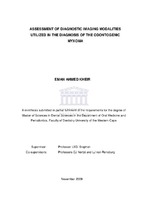| dc.description.abstract | Odontogenic myxoma (OM) is one of the rare odontogenic tumours that affect the
maxilo-facial regions. Skeletal myxomas are more common than soft tissue types
in the facial regions. Odontogenic myxomas (OM) are non metastasizing tumours and therefore are considered benign. These lesions are known for their distinctive infiltrative nature which makes complete surgical removal a challenging task.Since the tumour occurs inside the bone and can reach a considerable size with little or no clinical manifestation, the radiologic examination remains the main method to determine the size and the extension of the tumour preoperatively.Aim of the study To assess the different imaging techniques which are currently in use for the diagnosis of the odontogenic myxomas.Materials and methods The images were retrieved from the library of the Department of Diagnostics and Radiology at the Tygerberg Oral Health Centre.Initially each of the imaging modalities was assessed independently to describe the imaging features of odontogenic myxoma on conventional radiograph,Computed Tomography (CT) and Magnetic Resonance Image (MRI). Secondly the imaging features of the three techniques were correlated and contrasted to determine the most valuable imaging modality in the diagnosis of the tumour.Results In this study we found that MRI was superior to other modalities in the ability to show and determine the true extension of the tumours. Therefore, MRI distinguished the tumour tissue from the surrounding structures and soft tissues.Myxomas were found to display characteristic patterns of growth on MRI. These patterns include lobulations and/or budding, nodulation and crevices formation.Moreover T2 weighted images deduced the contents of the tumour by emitting different signal intensities from the various components of the tumours.Additionally, characteristic pattern of contrast uptake differentiated the
myxomatous, collagenous parts and presumed the nature of the trabeculae
whether it is bony or fibrous.CT also showed the tumour and determined the subtle extension of the tumour into the adjacent structures and bone. Expansion and status of the cortical margin were reliably detected on CT. It also determined the pattern of growth in all tumours whether it is lobulation and/or budding, crevices formation or combination of them. In the present study this feature seemed to be a
characteristic finding for all the tumours on CT. Moreover CT was able to compare densities of the tumours to surrounding muscles.Conventional radiography (CR) showed great limitations with regard to diagnostic abilities. Although it displayed the existence of the abnormality in all cases,conventional radiograph failed to detect margins and extension in most of the lesions. Therefore conventional radiograph is not reliable for presurgical assessment of the tumour or in differentiation the tumour from other benign and some malignant tumour. Conclusion In spite of the many limitations and shortcomings, conventional radiography remains the preliminary step in the diagnosis process. However
digital imaging techniques provide images of great diagnostic value which is
especially helpful in the diagnosis of odontogenic myxoma. | en_US |

